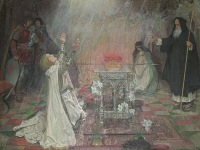Difference between revisions of "Holy Grail"
m (Text replacement - "http://nordan.daynal.org" to "https://nordan.daynal.org") |
m (Text replacement - "http://" to "https://") |
||
| Line 3: | Line 3: | ||
==Origin== | ==Origin== | ||
[https://nordan.daynal.org/wiki/index.php?title=English#ca._1100-1500_.09THE_MIDDLE_ENGLISH_PERIOD Middle English] ''greal'', ''graal'', from Middle French, bowl, grail, from Medieval Latin ''gradalis'' | [https://nordan.daynal.org/wiki/index.php?title=English#ca._1100-1500_.09THE_MIDDLE_ENGLISH_PERIOD Middle English] ''greal'', ''graal'', from Middle French, bowl, grail, from Medieval Latin ''gradalis'' | ||
| − | *[ | + | *[https://en.wikipedia.org/wiki/12th_century 12th Century] |
| − | The word graal, as it is earliest spelled, comes from Old French ''graal'' or ''greal'', cognate with Old Provençal ''grazal'' and Old Catalan ''gresal'', meaning "a cup or bowl of earth, wood, or metal" (or other various types of vessels in different [ | + | The word graal, as it is earliest spelled, comes from Old French ''graal'' or ''greal'', cognate with Old Provençal ''grazal'' and Old Catalan ''gresal'', meaning "a cup or bowl of earth, wood, or metal" (or other various types of vessels in different [https://en.wikipedia.org/wiki/Occitan Occitan] dialects). The most commonly accepted etymology derives it from Latin ''gradalis'' or ''gradale'' via an earlier form, ''cratalis'', a derivative of ''crater'' or ''cratus'' which was, in turn, borrowed from [[Greek]] ''krater'' (a two-handed shallow cup). Alternate suggestions include a derivative of ''cratis'', a name for a type of woven basket that came to refer to a dish, or a derivative of [[Latin]] ''gradus'' meaning "'by degree', 'by [[stages]]', applied to a dish brought to the table in different stages or services during a meal". |
==Definitions== | ==Definitions== | ||
*1capitalized : the cup or platter used according to medieval [[legend]] by [[Christ]] at the [[Last Supper]] and thereafter the object of knightly [[quests]] | *1capitalized : the cup or platter used according to medieval [[legend]] by [[Christ]] at the [[Last Supper]] and thereafter the object of knightly [[quests]] | ||
*2: the object of an extended or [[difficult]] quest | *2: the object of an extended or [[difficult]] quest | ||
==Description== | ==Description== | ||
| − | The '''Holy Grail''' is a dish, plate, stone, or cup that is part of an important theme of [ | + | The '''Holy Grail''' is a dish, plate, stone, or cup that is part of an important theme of [https://en.wikipedia.org/wiki/Arthurian_literature Arthurian literature]. A grail, wondrous but not explicitly "[[holy]]," first appears in ''[https://en.wikipedia.org/wiki/Perceval,_the_Story_of_the_Grail Perceval le Gallois]'', an unfinished romance by [https://en.wikipedia.org/wiki/Chr%C3%A9tien_de_Troyes Chrétien de Troyes]: it is a processional [https://en.wikipedia.org/wiki/Salver salver] used to serve at a [[feast]]. Chrétien's story attracted many continuators, translators and [[interpreters]] in the later 12th and early 13th centuries, including [https://en.wikipedia.org/wiki/Wolfram_von_Eschenbach Wolfram von Eschenbach], who makes the grail a great precious stone that fell from the sky. The Grail legend became interwoven with legends of the [https://en.wikipedia.org/wiki/Holy_Chalice Holy Chalice]. The connection with [https://en.wikipedia.org/wiki/Joseph_of_Arimathea Joseph of Arimathea] and with vessels associated with the [[Last Supper]] and [[crucifixion]] of [[Jesus]], dates from [https://en.wikipedia.org/wiki/Robert_de_Boron Robert de Boron's] ''Joseph d'Arimathie'' (late 12th century) in which Joseph receives the Grail from an [[apparition]] of Jesus and sends it with his followers to Great Britain. Building upon this theme, later writers recounted how Joseph used the Grail to catch Christ's blood while interring him and how he founded a line of guardians to keep it safe in Britain. The legend may combine Christian lore with a [https://en.wikipedia.org/wiki/Celtic_mythology Celtic myth] of a cauldron endowed with special powers.[https://en.wikipedia.org/wiki/Holy_grail] |
[[Category: Mythology]] | [[Category: Mythology]] | ||
Latest revision as of 00:08, 13 December 2020
Origin
Middle English greal, graal, from Middle French, bowl, grail, from Medieval Latin gradalis
The word graal, as it is earliest spelled, comes from Old French graal or greal, cognate with Old Provençal grazal and Old Catalan gresal, meaning "a cup or bowl of earth, wood, or metal" (or other various types of vessels in different Occitan dialects). The most commonly accepted etymology derives it from Latin gradalis or gradale via an earlier form, cratalis, a derivative of crater or cratus which was, in turn, borrowed from Greek krater (a two-handed shallow cup). Alternate suggestions include a derivative of cratis, a name for a type of woven basket that came to refer to a dish, or a derivative of Latin gradus meaning "'by degree', 'by stages', applied to a dish brought to the table in different stages or services during a meal".
Definitions
- 1capitalized : the cup or platter used according to medieval legend by Christ at the Last Supper and thereafter the object of knightly quests
- 2: the object of an extended or difficult quest
Description
The Holy Grail is a dish, plate, stone, or cup that is part of an important theme of Arthurian literature. A grail, wondrous but not explicitly "holy," first appears in Perceval le Gallois, an unfinished romance by Chrétien de Troyes: it is a processional salver used to serve at a feast. Chrétien's story attracted many continuators, translators and interpreters in the later 12th and early 13th centuries, including Wolfram von Eschenbach, who makes the grail a great precious stone that fell from the sky. The Grail legend became interwoven with legends of the Holy Chalice. The connection with Joseph of Arimathea and with vessels associated with the Last Supper and crucifixion of Jesus, dates from Robert de Boron's Joseph d'Arimathie (late 12th century) in which Joseph receives the Grail from an apparition of Jesus and sends it with his followers to Great Britain. Building upon this theme, later writers recounted how Joseph used the Grail to catch Christ's blood while interring him and how he founded a line of guardians to keep it safe in Britain. The legend may combine Christian lore with a Celtic myth of a cauldron endowed with special powers.[1]
